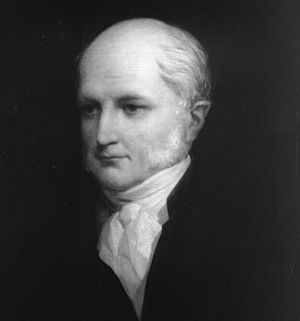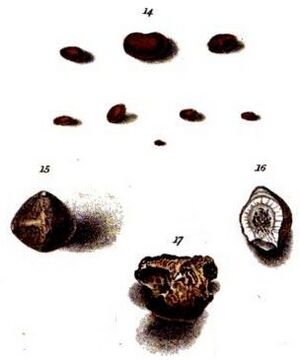William Prout facts for kids
Quick facts for kids
William Prout
|
|
|---|---|

Portrait of William Prout
by Henry Wyndham Phillips |
|
| Born | 15 January 1785 Horton, Gloucestershire, England
|
| Died | April 9, 1850 (aged 65) London, England
|
| Nationality | English |
| Alma mater | Edinburgh University (M.D.) (1811) |
| Known for | Prout's hypothesis |
| Awards | Copley Medal (1827) |
| Scientific career | |
| Fields | Chemistry Medicine |
William Prout (born January 15, 1785 – died April 9, 1850) was an English scientist. He was a skilled chemist and a doctor. Today, he is mostly remembered for something called Prout's hypothesis.
Contents
About William Prout
William Prout was born in a place called Horton, Gloucestershire, England, in 1785. When he was 17, he began his education with a clergyman. Later, he studied at the Redland Academy in Bristol. He then went to Edinburgh University and became a doctor in 1811.
After finishing his studies, Prout worked as a doctor in London. But he also spent a lot of his time doing important research in chemistry. He was very interested in how chemicals work inside living things.
Prout's Discoveries in Chemistry and Medicine
William Prout did many studies on the liquids produced by living organisms. He believed these liquids came from the body's tissues breaking down.
In 1823, he made an amazing discovery. He found that our stomach juices contain hydrochloric acid. This acid helps us digest food. He also figured out how to separate this acid from the stomach juice.
A few years later, in 1827, Prout suggested a way to group different types of food. He divided them into sugars and starches, oily substances, and a group he called "albumen." We now know these as carbohydrates, fats, and proteins. This was a very important idea for understanding nutrition!
Prout's Hypothesis: Building Blocks of Elements
Prout is also famous for his ideas about physical chemistry. In 1815, he came up with a bold idea, which is now called Prout's hypothesis.
He looked at the weights of different elements. He noticed that the weight of every element seemed to be a whole number multiple of the weight of hydrogen.
Prout thought that the hydrogen atom might be the most basic particle. He called this basic particle "protyle." He believed that all other elements were made up of different numbers of these hydrogen atoms joined together.
Later, scientists found that Prout's hypothesis wasn't exactly right. More accurate measurements showed that atomic weights are not always perfect whole numbers. However, his idea was a huge step forward in understanding the structure of atoms.
In 1920, a scientist named Ernest Rutherford discovered a new particle. He named it the proton. One reason he chose this name was to honor William Prout and his important early ideas about the building blocks of matter.
Other Contributions and Recognition
William Prout also helped improve the barometer, which is a tool used to measure air pressure. His design was so good that the Royal Society of London made it a national standard.
He became a Fellow of the Royal Society in 1819. This is a very high honor for scientists in England. In 1827, he received the Copley Medal, another very important award for his scientific work.
Prout also wrote a book called Chemistry, Meteorology, and the Function of Digestion, considered with reference to Natural Theology. In this book, he used the word "convection" to describe how heat moves through liquids or gases.
In 1814, William Prout married Agnes Adam. They had six children together. He passed away in London in 1850.
Today, there is even a unit of nuclear binding energy named after him, called the "Prout." It shows how important his work was in the history of science.
See also
 In Spanish: William Prout para niños
In Spanish: William Prout para niños


